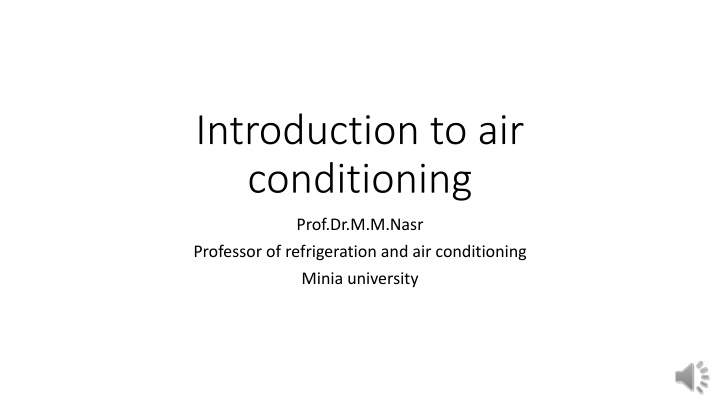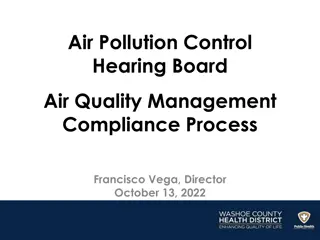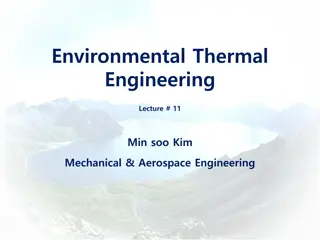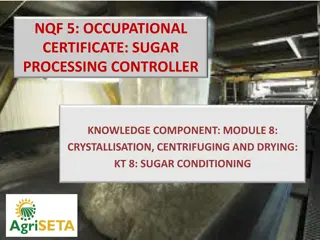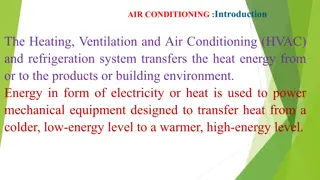Introduction to Air Conditioning by Prof. Dr. M.M. Nasr
Professor M.M. Nasr from Minia University provides an in-depth overview of air conditioning, covering topics like air treatment for comfort and health, achieving optimal temperature and humidity conditions, and more. Explore the fundamental principles and components of air conditioning systems, including psychrometrics and properties of moist air.
Download Presentation

Please find below an Image/Link to download the presentation.
The content on the website is provided AS IS for your information and personal use only. It may not be sold, licensed, or shared on other websites without obtaining consent from the author.If you encounter any issues during the download, it is possible that the publisher has removed the file from their server.
You are allowed to download the files provided on this website for personal or commercial use, subject to the condition that they are used lawfully. All files are the property of their respective owners.
The content on the website is provided AS IS for your information and personal use only. It may not be sold, licensed, or shared on other websites without obtaining consent from the author.
E N D
Presentation Transcript
Introduction to air conditioning Prof.Dr.M.M.Nasr Professor of refrigeration and air conditioning Minia university
Air Conditioning Air Conditioning Air conditioning in the general sense is the treatment of air in the building or the place to be adapted to make it more suitable for human comfort and health or to provide the appropriate atmosphere for the work of some machines or industrial processes and to achieve optimal conditions of temperature and humidity and air movement and air distribution and reduce dust and odors or harmful gases and microbes
Summer air conditioning system Summer air conditioning system R S Return air Supply air Conditioned space Mixing chamber Filter Cooling coil Heating coil Outdoor air Supply O m cc ch air duct Air damper Supply fan Exhaust fan Exhaust air Return air duct
Psychrometric (Properties of Moist Air) Psychrometric (Properties of Moist Air) Composition of moist air Moist air is a mixture of dry air and water vapor On the other hand the dry air is mechanical mixture of gases. The volume percentage of these gases are: Oxygen Nitrogen Hydrogen Argon Carbon dioxide O2 N2 H2 A CO2 20.99 78.03 0.01 0.94 0.03 The mean molecular mass of dry air M=32x0.2099+28.02x0.7803+2.02x0.0001+39.91x0.0094+44x0.0003 =28.97 Gas constant for dry air = universal gas constant/M Ra=8314.66/28.97=287 J/kg K The water vapor in the atmoshere is usually in the form of super heated steam at law partial pressures and temperatures. Therefore it can be considered as ideal gas. Gas constant of water vapor, Rw Rw=8314.66/18.02=461 J/kg K
Properties of air vapor mixtures Properties of air vapor mixtures According to Dalton s law, dry air and water vapor each completely occupy a space filled by the mixture of the two gases through the other were not present, and the total pressure of the mixture is the sum of the partial pressures of the water vapor and the dry air. PT= Pa+ Pv Also, mT= ma+ mv VT = Va= Vv TT= Ta = Tv
Absolute humidity:(vapor density) Absolute humidity:(vapor density) The absolute humidity of the air is defined as the actual weight of water vapor in kg contained in m3 of air vapor mixture air-vapor mixture Absolute humidity = 2.772/100= 0.02772 kg/m3 Volume=100m3 mvapor=2.772kg
Relative humidity(RH) Relative humidity(RH) Relative humidity is the ratio of the actual weight of water vapor in air in a given volume at a given temperature relative to the weight of water vapor contained in the same volume of saturated air at the same temperature. actual air-vapor mixture saturated air-vapor mixture Volume=100m3 volume=100m3 mvapor=2.772kg mvapor=3.96kg t=35oC t=35oC RH = mva/mvs =2.772/2.96=0.7or70% From ideal gas gas laws at t=constant, V=constant Pva/pva = mva/mvs RH = Pva/pva This Also, the Relative humidity is defined as the ratio of the partial pressure of the water vapour in moist air at a given temperature, t, to the partial pressure of saturated water vapour in air at the same temperature, t. RH
Specific humidity(w) or humidity ratio Specific humidity(w) or humidity ratio It is the mass in kg of water vapor contained in the air vapor mixture per kg of dry air. air-vapor mixture Specific humidity = mv/mda Volume=100m3 = 2.772/108.7 mvapor=2.772kg = 0.0255 kg/kg dry air mdry air =108.7kg Using the perfect gas laws mv Pv V/ RwT Pv Ra w= = = ma Pa V/ RaT Pa Rv 287 Pv Pv w = =0.622 Pv/Pa =0.622 461 Pa PT - Pv
Dew point temperature( Dew point temperature(tdp tdp) ) It is the temperature of air at which water vapor in air starts condensing. actual air-vapor mixture saturated air-vapor mixture pva=? at 35oC pvs=5.628 kPa mvapor=2.772kg mvapor=3.96kg t=35oC t=35oC Pva/pvs = mva/mvs Pva =pvs mva/mvs = 5.628x2.772 = 3.94 kPa, 3.96 From tables at 3.94kPa the temperature=28.6oC = tdp
Dry bulb temperature (DBT) Temperature of air as registered by an ordinary thermometer Wet bulb temperature (WBT) Temperature registered by a thermometer whose bulb is covered by a wetted wick and exposed to a current of rapidly moving air
Example Example A room 7 m x 4 m x 4 m is occupied by an air-water vapor mixture at 38 C. The atmospheric pressure is 1 bar and the relative humidity is 70%. Determine the humidity ratio, dew point, mass of dry air and mass of water vapor. If the mixture of air-water vapor is further cooled at constant pressure until the temperature is 10 C, find the amount of water vapor condensed. Solution. Given : v = 7 x 4 x 4 = 112 m3; Td= 38 C = 38 + 273 = 311 K ; Pb = 1 bar ; RH = 70% = 0.7
Humidity ratio Humidity ratio First of all, let us find the partial pressure of water vapor (Pv). From steam tables, we find that saturation pressure of vapor corresponding to a temperature of 38 C is, Ps = 0.066 24 bar We know that relative humidity (RH),0 .7 = pv /ps pv = 0.7 ps = 0.7 0.066 24 = 0.046 368 bar We also know that humidity ratio, =0.028841/= 0.953532 = 0 0302 kg/kg of dry air = 30.2 g /k g of dry air Ans.
Dew point temperature Dew point temperature Since the dew point temperature (tdp) is the saturation temperature corresponding to the partial pressure of water vapour (Pv), therefore, from steam tables, we find that corresponding to a pressure of 0.046 368 bar, the dew point temperature is tdp=31.56 C Mass of dry air Pressure of dry air = Pb - Pv =1 - 0.046 368 = 0.953 632 bar =0.953 632 x 105 = 95363.2 N/m2 ...( 1 bar = 105 N/m2) We know that Mass of water vapour We know that humidity ratio (W), (Taking Ra=287 J/kgK)
Percentage Humidity. Percentage Humidity. Percentagehumidity is defined as the ratio of the actualweight of water vapor in the air per kilogram of dryair to the weight of water vapor required tosaturate completely 1 kg of dry air at the sametemperature. Percentage humidity, like relativehumidity, is given in percent. Notice, however,that percentage humidity is associated with theweight of water vapor per unit weight of air,whereas relative humidity is associated with theweight of water vapor per unit volume of air. 98 642 N/m2 Dry 30 C Wet 20 C t w 10.914 10.99 10.58 wss 27.945 28.09 27.32 ,% 39.1 39.12 38.73 RH,% 40 40.16 39.75 Ps, kPa 0.017 01 bar 1.7058 Pss, kPa 0.042 42 bar 4.2460 4.2460 Cal. chart98 642 char101.308 1.6884
Thanks Prof.Dr.M.M.Nasr Mechanical Power and Energy Dept.
